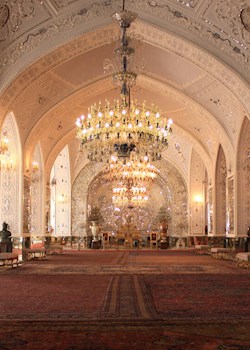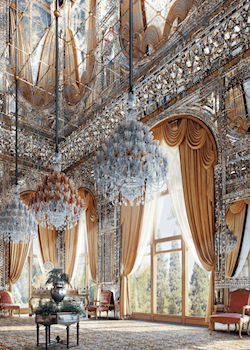Attractions
The Golestan Palace
Golestan palace
If you are interested in Iran's history, culture and art, you know that Tehran can be a great tourist destination. Golestan Palace is one of the historical places of Tehran, whose beauty, glory, and value have made tourists from all over Iran and the world interested in visiting it.
This building, which is currently known as Golestan Museum Palace, is a 440-year-old building and one of the architectural masterpieces of the Safavid era.
The extremely beautiful and unique architecture, on the one hand, and the important events that happened in this palace throughout history, on the other hand, have made this building important. In this article, we want to visit the Golestan Palace, one of the top sightseeing places in Tehran. Stay with us.
History of Golestan Palace
In fact, it is not possible to determine exactly which period the Golestan Palace belongs to. The construction of this palace began in the Safavid era, but in the subsequent periods, it was renovated several times, and some extensive changes were made.
With the beginning of the reign of the Zand family in Iran, the Palace was renovated by order of Karim Khan Zand, and parts were added to the building during this period. But its shape was still very different from today's building.
The architecture of Golestan Palace and various buildings
Golestan Palace has changed many times during its 400-year-old history. In some periods, parts were added to it, and there are also documents in which some parts were completely destroyed or removed.
Shams al-Amara or the palace of the emperor
One of the most prominent buildings of the Palace, which is also known as Shahneshah Palace, is Shams-ul-Amara, which is located on the eastern side of the building. This building was built during the time of Naser al-Din Shah Qajar in two years (between 1244 and 1246 AH). The importance of Shams al-Amara can be found in the beauty of its architecture as well as the height and size of the building. This building was built on five floors with a height of 35 meters, which was the tallest building in Tehran at the time.
Shams-ul-Amara was known as a symbol of Tehran before the construction of Sardar Bagh National. Apart from the height of the building, another unique feature of Shams al-Amara is that it was the first building in Tehran that was made of metal. All the columns on the upper floors of the building, as well as the guards, are all made of cast iron.
Salam hall or museum hall
Another main hall of the Palace is Salam Hall, which is used as a museum these days, and for this reason, it is sometimes called the Museum Hall. This section was also added to the Golestan Palace during the Qajar period in 1254. The architecture of this section was done by Sani al-Molk (Haj Abulhasan Memarbashi).
The reason for naming this building is that during the reign of Naser al-Din Shah Qajar, it was decided to move the peacock throne (the sun throne) from the mirror room to this part of the palace, and official greetings and formal greetings were held in this part of the palace.
In this way, the name of this hall was gradually changed to the Hall of Salam. This hall has nine windows facing the south garden of the Palace, and with an area of 1000 square meters, it is known as the largest hall of Golestan Palace.
Hall of Mirrors
Another main part of the Palace is the Hall of Mirrors, the construction of which was started in 1253 by Sani al-Molk and lasted until 1261. Hall of Mirrors is located in the west of Golestan Palace. Before this hall was built in this part of the palace, there was a mansion with forty wooden columns called Almasieh Mansion.
Kamal al-Molk's famous painting of Naser al-Din Shah Qajar also shows the king in the same part of the palace, i.e., the Hall of Mirrors. Of course, the hall is much smaller than what can be seen in Kamal al-Molk's painting. In fact, by drawing this painting, which took about five years to work on its details, Kamalul Molk intended to depict the splendor of Homayoni Palace. This painting was used in many official ceremonies at that time.
Ivan Takht Marmar or divan house
Ivan Takht Marmar, Ivan Daralamare or Divankhane, is the oldest building in Golestan Palace. This building was built in 1173 during the time of Karim Khan Zand. Ivan Takht Marmar, called by this name because of the placement of the marble throne in it, was used by the Qajar kings to congratulate the people on Nowruz and other holidays during the Qajar era. The porch of the marble bed was extensively changed and renovated twice throughout history.
These changes were made once in 1206 and during the time of Agha Mohammad Khan Qajar. At that time, Agha Mohammad Khan marched to Shiraz and by attacking Vakil Palace, he took a lot of booty from this palace, including several tall mirrors, marble columns, and tall doors, and brought it to Tehran.
He planned to use these structures and objects he brought from Shiraz in the Palace. Since the doors and columns were too tall, he ordered major changes to be made in the marble throne porch so that the columns and doors could be used in the structure of this part of the palace.
Abiz Palace
Abiz Palace is another important building of Golestan Palace, which was built to keep the gifts that were sent to Naseruddin Shah. At the end of the reign of Naser al-Din Shah, Sultan Abdul Hamid, the Ottoman king, sent several valuable and exquisite gifts to the Shah of Iran.
Since most of the palace's buildings kept other important and valuable things and gifts, Naser al-Din Shah ordered a new building to be built in the southwest corner of the palace to house these gifts.








